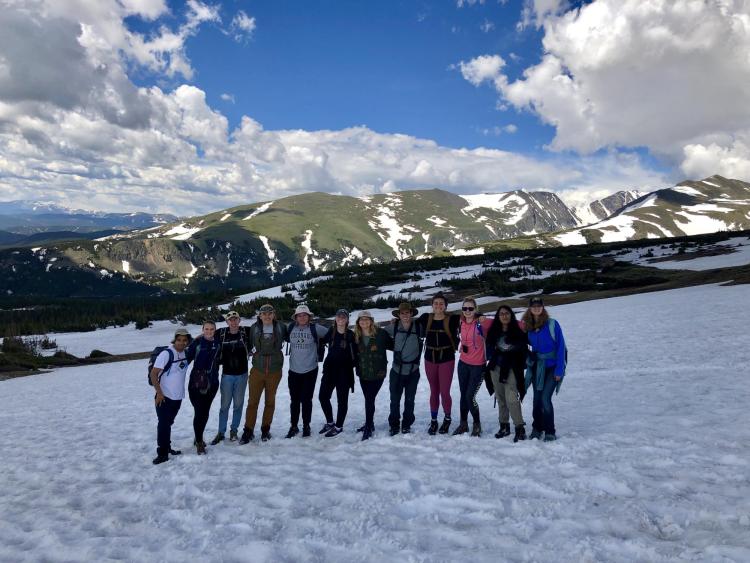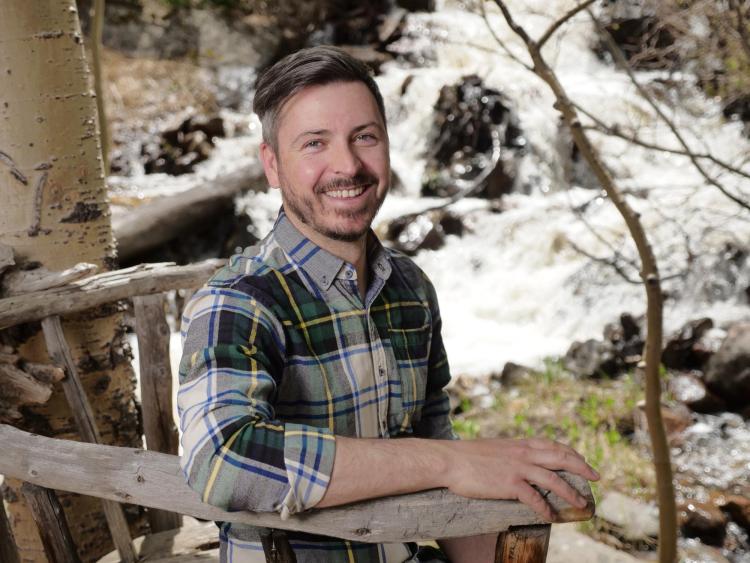‘Classroom in the sky’ inspires generations of researchers, students
As the Mountain Research Station celebrates turning 100, a look back on its history—and toward its future
The sky was a perfect crystal blue as 50 undergraduate students from the University of Colorado Boulder spent their Saturday atop a mountain clustered around grasshoppers.
Plastic cages scarcely taller than the swaying golden grasses lay scattered about—some excluding the insects, others preventing their escape—all to see how the creatures responded to the vegetation within.
Rather than assist with the research, which was being conducted by a postdoctoral student from the University of Oregon, these general biology students hiked up a narrow, rugged path amid dense pine and yellowing aspens to this break in the trees, called Elk Meadow, to learn about research—both its legacy and its future almost 10,000 feet above sea level.

Top of the page: Bill Bowman works with a student up on the tundra. Photo by Patrick Campbell/University of Colorado Boulder. Above: The Mountain Research Station is run by a dedicated set of staff, students and faculty who maintain equipment, gather data and work on one of the most beautiful parts of CU Boulder's campus. (Credit: CU Boulder)
Just north of Nederland, about 26 miles from Boulder, is CU Boulder’s “classroom in the sky”—the Mountain Research Station. It is the university’s highest research facility and is home to some of the world’s longest-running alpine research, from how trees respond to increasing wildfires, to the charismatic little pikas and chickadees that call these slopes home, to the changing composition of the soil itself.
Graduate students and some undergraduates in the natural sciences find their way here. And yet general biology students have rarely had the opportunity to visit and learn about the facility—until now.
“You usually see graduate students or faculty or staff up there, but undergrads are rarer,” explains Warren Sconiers, an associate teaching professor in the Department of Ecology and Evolutionary Biology (EBIO) at CU Boulder and the trip’s organizer.
“We (EBIO professors) want them to know what opportunities there are in research, and as soon as they realize it, and as soon as they want to (participate), get them out here as a part of the research at Boulder.”
The Mountain Research Station’s legacy
The Mountain Research Station has long been a pilar of support for alpine research and education. And that legacy is clear in the make-up of the place itself—from classrooms and offices to a dining hall and living spaces to bird-nest boxes used to study hybridization hanging on pine trees.
The Mountain Research Station, originally known as Science Lodge and Science Camp, was built in 1920 on what once was federal land. It is one of the oldest alpine field research facilities in the world, and one of the best, argues Bill Bowman, the station’s former director and a professor emeritus in EBIO. Bowman says that is in large part because of the staff that make this this place run and the expert leadership of John Marr, who became the station’s director in 1950.
Marr founded many of the programs the station is now known for, like the Mountain Climate Program, and provided the scientific groundwork for the current Niwot Ridge Long-Term Ecological Research (LTER) program, which is funded by the National Science Foundation and researches how mountain ecosystems are transforming in response to climate change. It is the only LTER spot focusing on alpine environments in North America and is one of the original LTERs, continuously funded since 1980.
Additionally, through the Mountain Climate Program—created to evaluate the relationship between climate and the major ecosystem types of the Front Range—the station is home to the longest continuous record of greenhouse gas measurements in the continental United States, found above timberline at around 11,500 feet, and the second-longest in the world, behind only the station on Mauna Loa in Hawaii.
The long-term data that’s been collected here is really priceless, and I think being at a place that’s contributed so much to our understanding of long-term change in climate and ecosystems is really special.”
“It’s really been one of the main places on the planet where we’ve learned about long-term changes in climate and mountain ecosystems,” says Scott Taylor, the station’s director and an associate professor in EBIO. “The long-term data that’s been collected here is really priceless, and I think being at a place that’s contributed so much to our understanding of long-term change in climate and ecosystems is really special.”
In addition to the LTER program and Mountain Climate Program, the Boulder Creek Critical Zone Program and the National Ecological Observatory Network (NEON) also conduct research near the station.
“We wouldn’t be able to do half of what we’ve done at the Mountain Research Station if it weren’t for (Marr’s) efforts,” Bowman says.
Taylor agrees, adding that the Mountain Research Station is “really unique. . . . Lots of places have research stations, but not a lot have this kind of history.”
That history, though, extends past just data to the people who have found their way here through the decades.
Generations of care
Bowman became involved with the station in the 1970s as an undergraduate in environmental, population and organismic biology (now EBIO and integrative physiology). At the time, Bowman worked with a graduate student in the lab of Professor Emeritus Jeff Mitton, who was studying forest genetics and needed help getting pine needle samples to run genetic analyses on them. Bowman, who loved to hike and snowshoe, volunteered.
Fast-forwarding through multiple graduate degrees, Bowman found himself back in Boulder, but this time as a professor. He was invited to participate in the LTER program, which at that time was more concerned with physical-environment conditions than with biology. Through his participation, Bowman began researching plant ecology and what factors determined which plants occurred where, how communities came together to alter the diversity, and how that influences ecosystem functioning.
It was through Bowman’s lab that Katharine Suding, now the principal investigator for the LTER program and a Distinguished Professor in EBIO, became involved in the program, then as a postdoctoral researcher.
In 1990, a few years after Bowman began his alpine research, he became the station’s director and stayed there for 30 years, until his retirement in 2021.
During his tenure, many repairs were completed on the station, including upgrading infrastructure and building the Moores-Collins Family Lodge and Kiowa classroom, which is across the parking lot from the Marr Lab, where the main offices are housed. He also helped start or expand several large research programs, which provided data for something that Bowman saw firsthand for decades: the effects of climate change on the station.
“I’ve clearly seen climate change come and establish itself as being something that we recognize and we can see symptoms of,” Bowman says. “Climate change is a factor that’s going to become more and more important in how the station operates.”
Additionally, under Bowman’s leadership, the Research Experiences for Undergraduates (REU) program, funded by the National Science Foundation, was established at the station. For more than 20 years, that program has brought undergraduates, including Sconiers, from across the United States and the globe to Colorado during the summers.
“It’s gratifying for the faculty who set those (REU) programs up to be able to see the investment come to fruition and see it passed on,” Bowman says. “That’s one of the most satisfying things that I’ve gotten while being director of the Mountain Research Station.”
Inspiring those to come
Sconiers was a student at the University of California, Irvine when he learned about the station. At the time, he was interested in research and graduate school but knew he needed to join a lab to do that. He began contacting faculty around campus, and one of them, Suding, then at UC Irvine, said yes—and recommended he pursue an REU.

Scott Taylor's research applies genomics and field experiments to natural hybrid zones and closely related taxa in order to investigate the architecture of reproductive isolation—the hallmark of speciation—and the genetic bases of traits relevant to speciation.
He applied and was accepted by the program at the Mountain Research Station. While there, he helped collect data detailing how the alpine landscape had been altered in response to climate change.
“The REU was critical for my career,” Sconiers says. “It was my first opportunity to devise a project from scratch, so come up with my own ideas and have it fit into a research interest, and then I got to collect all of the data, so I got to carry it through. In class, you’re just learning how this works or doing small versions of things, but this was the first chance I had to do everything.”
After graduating, Sconiers was a lab tech for Suding for a year before going on to graduate school for entomology. He eventually became a professor at the University of the Ozarks in Arkansas and stayed there for a few years.
It was about that time that he ran into Suding, who told him about an opening at CU Boulder.
That brought him back to the university, this time as a teaching professor and a researcher with the Institute of Arctic and Alpine Research—which runs the Mountain Research Station—where he studies how plant species composition affects insect diversity at high elevations.
By bringing his general biology students to the station, he hopes to introduce the next generation of scholars to its possibilities.
“The idea of the trip was so the students can talk with the faculty who do research there and potentially just be up there for research and other things, so really just to take this resource that’s unique to CU Boulder and introduce it to students,” Sconiers says. “Let them know that you can have an interest, and that’s enough to get involved.”
Taylor, who hopes to use his tenure as director to make the station more visible and inclusive for everyone, is thrilled.
“There’s the scientific legacy of the station, but then also there’s one of inspiring generations to care about alpine ecosystems and mountain ecosystems,” Taylor says.
“That’s partially why I love field stations. They have such a big impact—a disproportional impact.”

